Max Griffin's Blog, page 4
June 7, 2023
What’s for dinner
Puttanesca Sauce
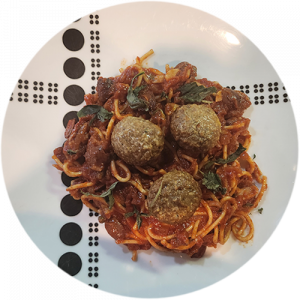 We had spaghetti and meatballs tonight, and I tried an awesome new sauce, puttanesca.
We had spaghetti and meatballs tonight, and I tried an awesome new sauce, puttanesca.
Of course, there’s a story behind this sauce. Several stories, in fact. One says that the name derives from the Latin word putida, which means “stinking”–the sauce calls for six garlic cloves. Another says that it derives from the Italian word puttana which means, er, I think the US term would be “working girl.” This story says that the establishments that employed these women would use the fragrent sauce to lure in customers. Or maybe to feed satisfied customers.
In any case, the sauce dates at least from Naples in the 1940s, and probably earlier. It’s got traditional Italian ingredients, is super easy, smells great while you’re cooking it, and has intense, savory flavor.
The version I’m posting here isn’t quite traditional–I’ve added a couple of ingredients. First, I’ve added brown sugar to cut the acidity of the tomatoes, and I’ve added ground fennel. The latter is an ingredient I’ve always put in spaghetti sauce to add a nice piquancy. I’ve also added a splash of Zinfandel, also to cut the acidity of the tomatoes.
The sauce calls for anchovies. Don’t worry–this won’t make your sauce taste fishy. Instead, it’s an essential feature of the sauce that adds the natural umani flavor that makes the sauce savory. If you want a vegetarian substitute, miso paste or soy sauce offer a similar flavor. You could also use Worcestershire sauce, but that contains anchovies so you may as well use the real thing. Versions from Compania usually omit the anchovies, which I don’t recommend.
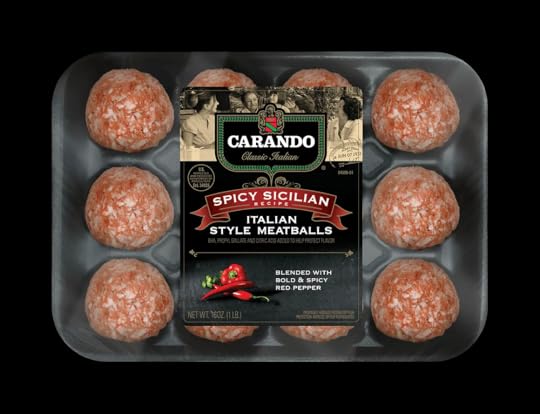 I admit I cheated a bit for dinner tonight–I didn’t make the meatballs. Instead I used Carando spicy Sicilian meatballs. These were inexpensive and tasted better than ones I’ve made from scratch. These had a bit of a bite to them; if you want, there is a milder version from the same company. In any case, these were about the same price as Italian sausage at the grocery story, and were already formed into tasty meatballs.
I admit I cheated a bit for dinner tonight–I didn’t make the meatballs. Instead I used Carando spicy Sicilian meatballs. These were inexpensive and tasted better than ones I’ve made from scratch. These had a bit of a bite to them; if you want, there is a milder version from the same company. In any case, these were about the same price as Italian sausage at the grocery story, and were already formed into tasty meatballs.
With so few ingredients, it’s advisable to get the best possible. For example, I used Kalamata olives from the deli, not the canned or bottled ones on the grocery shelves, and San Marzano tomatoes.
 PrintPuttanesca SauceCourse Main CourseCuisine ItalianPrep Time 30 minutes minutesCook Time 30 minutes minutesServings 4 peopleEquipment1 Skillet1 Sauce pan for spaghetti1 Collander to drain spaghettiIngredients1 lb Spaghetti1 lb meat balls (optional)1/4 C Olive oil–two swirls about the pan6 cloves Garlic, thinly sliced. Yes, six. 2 oz Anchovy filets, finely chopped. If in oil or brine, drain before chopping.1 red onion, finely chopped1/4 C Zinfandel or any sweet, white wine–optional, but this adds a bit sweetness to the sauce1/2 C Kalamatta olives, pitted and sliced in half1/4 C Capers, drained. 28 oz Crushed tomatoes. I used San Marzano tomatoes, but any canned, crushed tomatoes will do.1 tsp ground fennel2 tbsp brown sugar (more or less, to taste)1/4 C fresh basil, choppedInstructionsPrepare and measure all ingredients prior to starting. That way you'll have everything at hand and won't have to stop in the middle of cooking the sauce.Cook the meatballs per the recipe or package instructions, if using.Cook spaghetti al dente, per the instructions on the package. That means you might cook it a couple minutes less than the package suggests so it's a little undercooked when you mix it with the sauce. That way, it will better absorb the sauce.Bring large skillet to temperature over medium heat. Let the skillet heat for four or five minutes before adding ingredients.Add olive oil to skillet and swirl so it covers the bottom.Add the chopped anchovies and thinly sliced garlic cloves to skillet. Toss so that they mix with the oil. After about a minute, the anchovies should start to disolve in the oil and the garlic should be fragrant and soft. Don't cook until it's brown!Add the onions to the pan and cook until they soften–about five minutes.Add the wine, olives, capers, and tomatos to the pan. Stir in the ground fennel and bring to a simmer. Simmer for about 15 minutes.Sprinkle the brown sugar over the sauce and thoroughly mix it in.By this time, the spaghetti should be done. Save a quarter cup of the water you cooked the spaghetti in and drain the noodles in the collander.Reduce the heat on the skillet and add the noodles. Mix thoroughly. Add half the chopped basil and mix. If the sauce is too thick, add a bit of the water you saved from cooking the spaghetti, one TBSP at a time.Plate the spaghetti, top with meatballs, grated parmesan, and the remaining basil.
PrintPuttanesca SauceCourse Main CourseCuisine ItalianPrep Time 30 minutes minutesCook Time 30 minutes minutesServings 4 peopleEquipment1 Skillet1 Sauce pan for spaghetti1 Collander to drain spaghettiIngredients1 lb Spaghetti1 lb meat balls (optional)1/4 C Olive oil–two swirls about the pan6 cloves Garlic, thinly sliced. Yes, six. 2 oz Anchovy filets, finely chopped. If in oil or brine, drain before chopping.1 red onion, finely chopped1/4 C Zinfandel or any sweet, white wine–optional, but this adds a bit sweetness to the sauce1/2 C Kalamatta olives, pitted and sliced in half1/4 C Capers, drained. 28 oz Crushed tomatoes. I used San Marzano tomatoes, but any canned, crushed tomatoes will do.1 tsp ground fennel2 tbsp brown sugar (more or less, to taste)1/4 C fresh basil, choppedInstructionsPrepare and measure all ingredients prior to starting. That way you'll have everything at hand and won't have to stop in the middle of cooking the sauce.Cook the meatballs per the recipe or package instructions, if using.Cook spaghetti al dente, per the instructions on the package. That means you might cook it a couple minutes less than the package suggests so it's a little undercooked when you mix it with the sauce. That way, it will better absorb the sauce.Bring large skillet to temperature over medium heat. Let the skillet heat for four or five minutes before adding ingredients.Add olive oil to skillet and swirl so it covers the bottom.Add the chopped anchovies and thinly sliced garlic cloves to skillet. Toss so that they mix with the oil. After about a minute, the anchovies should start to disolve in the oil and the garlic should be fragrant and soft. Don't cook until it's brown!Add the onions to the pan and cook until they soften–about five minutes.Add the wine, olives, capers, and tomatos to the pan. Stir in the ground fennel and bring to a simmer. Simmer for about 15 minutes.Sprinkle the brown sugar over the sauce and thoroughly mix it in.By this time, the spaghetti should be done. Save a quarter cup of the water you cooked the spaghetti in and drain the noodles in the collander.Reduce the heat on the skillet and add the noodles. Mix thoroughly. Add half the chopped basil and mix. If the sauce is too thick, add a bit of the water you saved from cooking the spaghetti, one TBSP at a time.Plate the spaghetti, top with meatballs, grated parmesan, and the remaining basil. The post What’s for dinner first appeared on Max Griffin.
May 24, 2023
The Manichean Fallacy
When we write fiction, we create fictional characters. Hitchcock famously said that the audience cares about the characters, while the plot is there to give the characters something to care about.
In order for the audience to care about the characters, our words need to breathe life into imaginary people. We do this by showing them interacting with the fictional world, including other people in that world. They need to act, speak, and think in ways that readers find credible. The more tools authors have in this creative process, the better. The Emotional Thesaurus, for example, is an invaluable tool that provides physical and emotional markers for emotions. Anything that provides a deeper understanding of people and their behaviors is a potentially useful tool for the fiction author.
Primal World BeliefsWhich brings us to the topic of this month’s newsletter. The most recent issue of Scientific American includes an article about primal world beliefs. The article summarizes the findings of an ongoing psychological study that claims to have identified twenty-six primal world beliefs, organized in dualistic pairings. These include broad world views like “the world is enticing/dull,” or “the world is safe/dangerous,” or “the world is alive/mechanistic.” Most of the other twenty-three primal world beliefs fall into one of the above three broad categories, and the combination of all twenty-six primal world beliefs summarizes whether one’s overall view that the world is “good” or “bad.” You can take the survey and find out what it says about you. It’s worth the time.
This is useful to fiction authors because it can help you construct a credible and consistent character. People will hold a mix world views, so making a credible character will not be “pure,” but rather will exhibit a mix of traits. If you create a bio for your characters as part of writing your novel, listing some of these traits could be helpful. It could also be helpful in terms of constructing oppositional traits for protagonists and antagonists, as well as providing a potential basis for common ground.
This tool, like most tools, is imperfect. Consider the pairing “the world is alive/mechanistic.” Some of the questions on the survey the specific question about which way you view the universe: alive or mechanisitc. I couldn’t answer because the proposed dualism is, in my view, meaningless. The world is neither of these things. Even worse, the questions leave undefined what “world” we are talking about. Is the world in question the physical world, or is it the cultural and social world? I was thinking of the physical world when I read the question, but others might think of the political world, or the cultural world, or Earth’s biome. Absent a definition, the question itself lacks meaning.
The question of whether or not physics is “mechanistic” is, however, resolved. This was the subject of a famous debate between Einstein and Heisenberg at the 1927 Solvay Conference. Einstein took the position that probability had no role in physics except as an imperfect way to estimate unknown and hidden variables—his view was mechanistic. Heisenberg’s uncertainty principle, on the other hand, is famous for Schrodinger’s cat that’s both dead and alive until the box is opened. Bell’s inequality and the experiments it inspired have resolved this debate in Heisenberg’s favor. God, if she exists, does indeed play dice with the universe.
Neither Einstein nor Heisenberg argued that the universe was “alive,” whatever that might mean. Definitions, again. The Devil is in the details. Or God, depending on your point of view.
Manichaen FallacyI’m more interested here in the notion of dualism. Each of the twenty-six “primal world views” are expressed as an either/or dualism. In the “alive/mechanistic” primal view, the dualism isn’t even remotely reality based if the world in question is the physical world. It’s a duality only for the uninformed—not that I expect most people to know about the Solvay conference or Bell’s inequality. But all of the “primal world views” are dualistic, and that’s the Manichean Fallacy of the title.
At one time, Manichaeism was one of the most wide-spread religions in the world. Founded in the third century by its prophet, Mani, it spread outward from the Sassanian empire as far west as the Roman Empire and east as China. Mani taught an elaborate dualistic cosmology which saw the world as a struggle between light and darkness, between good and evil. It was a syncretic religion in that it combined aspects of Gnosticism, Christianity, Judaism, and Buddhism, all of which would have been present in Sassanian empire, which roughly corresponded to today’s Iran and Iraq. It thrived from the third to seventh centuries, but had largely disappeared by the fourteenth century, although allegedly adherents still exist in southern China.
The dualism that formed the basis of the religion has had influence throughout history. Augustine of Hippo was a Manichaean before converting to Christianity, for example. The Cathars in medieval France had a dualistic theology that may have been Manichean in origin. Modern-day examples of dualistic world views are left as an easy exercise for the reader.
The “Manichaean Fallacy” refers to the religion’s dualistic premise, which sees the world through the lens of polar opposites, like “day” and “night,” or “spiritual” and “material,” or “good” and “evil.” It’s a fallacy because a dualistic worldview ignores the boundaries between these opposites, places which are not purely one or the other. Dusk and dawn, for example, are transitions between “day” and “night,” and not purely one or the other. Human lives are a mix of spiritual and material—the Biblical admonition that we don’t live by bread alone acknowledges that we do, indeed, live by bread.
The boundaries are where the interesting people live and where interesting things happen. They are the places of strange attractors and chaos. Mysteries dwell in the shadows of dusk and dawn, things unseen and unknown. Anything can happen at an event horizon.
Connection to CharacterizationIn fiction we need to create credible characters. Lists like the Primal Worlds Beliefs give us another way to think about what motivates people and to construct beleivable characters. They can be especially useful in constructing character bios as part of your planning process. Believable characters are certainly more than an assembly of dualisms, but it still provides one way to think about characters.
It’s easy enough to write a character that’s pure evil. Think Hitler, and go from there. But the exception proves the rule. The most interesting characters are a mix of good and evil rather than a pure type. What makes Raymond Chandler’s Philip Marlowe interesting is that he’s an anti-hero, a flawed character in a flawed world. The same is true of Sam Spade in Dashiell Hammett’s novels. Both characters are more credible and well-rounded than Agatha Christie’s Miss Marple. The latter might be more fun, but she’s not as believable.
In movies, Anakin Skywalker “has good in him,” even though he does the most evil of acts. We see his evolution from a little boy who misses his mother, to the evil dark lord, to his moment of redemption. Hannibal Lector never gets a redeeming moment, but his charm and his sense of justice and humor give him redeeming characteristics. Indeed, his charm makes him more chilling than he might otherwise be. Even the killer in Silence of the Lambs loves his dog. But then, Hitler loved his dog Blondi, too.
Holy wars are another risk of the Manichean Fallacy: implicit in holy wars is the belief that the ends justify the means. Manichean dualism can lead to exactly this state of mind, where you’re on the side of the angels and any tactic is justified against the devils on the other side, even murder. This provides another way in which dualism can be used in fiction. The relentless Javert in Hugo’s Les Miserable is, in some ways, an example of an anything-goes character who eventually has an epiphany and suicides.
In terms of characterization, the point is that dualistic pairings can be helpful in constructing believable characters. Credible characters are usually a mix of beliefs; they are impure alloys, made stronger for the impurities. The “primal world beliefs” are based on textual research and provide one taxonomy of beliefs that can inform character biographies. Just remember to design characters the way an engineer designs an alloy for a beam. The strength of your characteriization derives from intentional impurities.
The post The Manichean Fallacy first appeared on Max Griffin.
May 21, 2023
What’s for Dessert
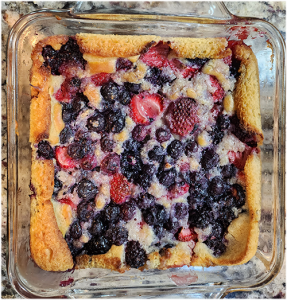 We share a monthly dinner and evening of conversation with another couple. We alternate who hosts the dinner. The host provides the main course and the other couple does the dessert. This month we were the “dessert” half of the equation, and I found a recipe by Melissa Riker for a mixed berry cobbler that I wanted to try. It turned out even better than I’d expected, so I thought I’d share it here.
We share a monthly dinner and evening of conversation with another couple. We alternate who hosts the dinner. The host provides the main course and the other couple does the dessert. This month we were the “dessert” half of the equation, and I found a recipe by Melissa Riker for a mixed berry cobbler that I wanted to try. It turned out even better than I’d expected, so I thought I’d share it here.
Usually, a cobbler starts with a fruit layer in the pan, topped with a biscuit layer–or sometimes a cake layer. Crisps are similar, except they use a streusel layer. The basic difference is that biscuits use butter, flour, sugar, milk and baking soda, so they are cake-like, while streusels use just use butter, flour, sugar and oats and are crisp rather than cake-like. If you omit the oats, instead of a “crisp” you get a “crumble.”
Anyway, this recipe qualifies as a cobbler since it has a biscuit-like dough. But instead of putting the fruit on the bottom and the dough on top, this reverses the process and puts the dough on the bottom and the fruit on the top. This gives a more cake-like basis for dish and makes it easier to plate.
My variation uses a bit more sugar than Melissa’s for the berries. I also added corn starch to the fruit to make it less runny. The cobbler in the picture used blueberries, while hers used a double portion of blackberries. Basically, any mix of berries or stone fruits totaling roughly two cups would work well. With similar recipes, I’ve used plums and they turned out awesome. I suspect you could use frozen fruit. If you do, I would add more corn starch and not thaw it out first. I think canned peaches would work well, too–if you use them, get some with “light syrup” and drain it first.
 PrintBerry CobblerPrep Time 15 minutes minutesCook Time 45 minutes minutesServings 6Author Melissa RikerIngredientsFor the Fruit6 oz Blackberries6 oz Blueberries6 oz Strawberries2/3 C Sugar1 TBSP Corn StarchFor the dough1 C Flour2 TSP baking powder1/2 TSP salt1 TSP Vanilla Extract1 C Milk (I used 2%)1/3 C Butter, melted and cooled slightlyInstructionsFruitPlace fruit in mixing bowlWhisk together the corn starch and the sugarStir the sugar and cornstarch mixture into the berries.Let the mixture rest for at least five minutes while you prepare the dough. This will let the sugar draw out the juices of the berries, a process called maceration. For the batterIn a separate bowl, sift together the flour, baking powder, and saltAdd in the milk and stir with a wooden spoon or wire whisk until mixed.Add the melted butter and vanilla and mix until combinedPut it together and bakePrepare an 8 inch square cake pan with non-stick spray.Pour the batter into the panTop the batter with the berry mixture. Be sure to scrape all the juices and sugar onto the batter as well.Bake for 50 minutes or until golden brown (It took only 43 minutes in my oven)Serve with ice cream or whipped cream.
PrintBerry CobblerPrep Time 15 minutes minutesCook Time 45 minutes minutesServings 6Author Melissa RikerIngredientsFor the Fruit6 oz Blackberries6 oz Blueberries6 oz Strawberries2/3 C Sugar1 TBSP Corn StarchFor the dough1 C Flour2 TSP baking powder1/2 TSP salt1 TSP Vanilla Extract1 C Milk (I used 2%)1/3 C Butter, melted and cooled slightlyInstructionsFruitPlace fruit in mixing bowlWhisk together the corn starch and the sugarStir the sugar and cornstarch mixture into the berries.Let the mixture rest for at least five minutes while you prepare the dough. This will let the sugar draw out the juices of the berries, a process called maceration. For the batterIn a separate bowl, sift together the flour, baking powder, and saltAdd in the milk and stir with a wooden spoon or wire whisk until mixed.Add the melted butter and vanilla and mix until combinedPut it together and bakePrepare an 8 inch square cake pan with non-stick spray.Pour the batter into the panTop the batter with the berry mixture. Be sure to scrape all the juices and sugar onto the batter as well.Bake for 50 minutes or until golden brown (It took only 43 minutes in my oven)Serve with ice cream or whipped cream. The post What’s for Dessert first appeared on Max Griffin.
May 18, 2023
What’s For Dinner
 Tonight we’re having seared ahi tuna with steamed baby bok choi. For the sauce, I used a variation on traditional ponzu dipping sauce that worked well with both the tuna and the bok choi.
Tonight we’re having seared ahi tuna with steamed baby bok choi. For the sauce, I used a variation on traditional ponzu dipping sauce that worked well with both the tuna and the bok choi.
As usual, I like my tuna grilled on the outside and rare on the inside, while Gene likes his cooked all the way through. With any kind of meat, it’s a challenge to reach the medium-well status that he prefers by grilling or pan-frying, but the sous vide cooker is fool-proof.
While Tulsa has a seafood market that flies in fresh fish, it’s both inconvenient and relatively expensive. Also, the fresh stock comes from the Gulf, so I’m not sure that the tuna isn’t of the “once-frozen” variety that the grocery store carries. In any casse, Sams carries frozen tuna, and I’ve found these to be indistinguishable to what the local fresh market carries, so I used these.
For the sous vide cooker, I put Gene’s tuna steak in a bag with some thyme, crushed garlic, and a tablespoon of olive oil, sealed the bag, and put it in a 115F bag for 35 minutes. It came out firm, moist, and cooked through, just like he likes it. I let it rest for five minutes, then finished it by coating it with black sesame seeds and searing it for about a minute on all sides. I seared my raw tuna at the same time.
For my tuna, I painted it with garlic-infused olive oil, and coated all sides with the black sesame seeds. I set the heat to medium-high, waited for the skillet to come to temperature, added a drizzle of the garlic-infused oil to the pan, and then added the two tuna steaks.
While the tuna sears and before the Maillard reaction completes, it will stick to the pan. But after a couple of minutes, it will release, and that’s when to turn it. If you try to turn it too soon, it will stick and you’ll have a mess, so be patient! The sous-vide tuna, being already cooked, releases before the raw tuna, so pay attention.
Sear both sides of the tuna, then use tongs to sear the edges, too. After this, rest the tuna steaks for about five minutes on a cutting board, then slice against the grain. To plate the dish, drizzle some of the sauce on the plate, array the tuna slices on the sauce, then drizzle more sauce over the fish.
You can fix the sauce ahead of time, or while the fish is in the sous vide cooker if you’re using one. It’s easy, and quite good. It doesn’t taste like authentic ponzu sauce, but it’s still tasty.
I steamed the baby bok choi in my microwave steamer for five minutes. That’s much healthier than roasting, and more energy efficient. Today’s recipe uses three gadgets from Amazon–the sous vide cooker, a hand blender (or infuser) and a microwave steamer. They are all really handy to have. The steamer in particular works well and is easy to clean up.
[image error][image error] [image error][image error] [image error][image error]
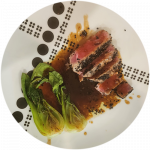 PrintGarlic-Lime SaucePonzu-like sauce for TunaCourse SauceCuisine JapanesePrep Time 10 minutes minutesServings 1 CEquipment1 Hand infuser1 Container to mix the sauce–a large coffee mug will doIngredients1 small lime, zest and juiced. May need more than one since you need a minimum of 1TBSP of juice.2 Cloves garlic2 TBSP Orange Juice1 TBSP Grated ginger (about 1/2 inch of pealed ginger root)1/2 C Soy sauce (or ponzu sauce if you can find it)2 TBPS Mirin, or a sweet white wine 2 TBSP Honey, or more to taste. 1/4 TSP Xanthum gum optional, for a thicker sauceInstructionsZest the lime and place the zest in the container you'll use to mix the sauceRoll the lime on your cutting board (this will help to release the juice), cut it in half, and juice it. You need to get at least 1 TBSP of juice, so it might take more than one lime to do this.Mince the garlic and add to the container. I used a garlic press instead of mincing, so I get mostly the oil and flavor and less fibrous residue.Peal and grate the ginger. A cheese grater works fine. Add it to the container.Add the orange juice. If you want to squeeze a fresh orange, go ahead, but if you've got OJ in the fridge, that works fine.Add the soy sauce, mirin, and honeyIf using, sprinkle xanthum gum over the liquid Now use your hand-infuser to mix the sauce. Move the infuser up and down in the liquid to be sure that it mixes throroughly. It will take a couple of minutes at most.The xanthum gum works almost instantly. If it's not thick enough for you, just add a bit more–it's tasteless. Remember, though, while you can add some, you can't take it out!Taste the sauce for sweetness. We like a sweeter sauce, so I used about double what the recipe calls for, but that's probably too sweet for most.
PrintGarlic-Lime SaucePonzu-like sauce for TunaCourse SauceCuisine JapanesePrep Time 10 minutes minutesServings 1 CEquipment1 Hand infuser1 Container to mix the sauce–a large coffee mug will doIngredients1 small lime, zest and juiced. May need more than one since you need a minimum of 1TBSP of juice.2 Cloves garlic2 TBSP Orange Juice1 TBSP Grated ginger (about 1/2 inch of pealed ginger root)1/2 C Soy sauce (or ponzu sauce if you can find it)2 TBPS Mirin, or a sweet white wine 2 TBSP Honey, or more to taste. 1/4 TSP Xanthum gum optional, for a thicker sauceInstructionsZest the lime and place the zest in the container you'll use to mix the sauceRoll the lime on your cutting board (this will help to release the juice), cut it in half, and juice it. You need to get at least 1 TBSP of juice, so it might take more than one lime to do this.Mince the garlic and add to the container. I used a garlic press instead of mincing, so I get mostly the oil and flavor and less fibrous residue.Peal and grate the ginger. A cheese grater works fine. Add it to the container.Add the orange juice. If you want to squeeze a fresh orange, go ahead, but if you've got OJ in the fridge, that works fine.Add the soy sauce, mirin, and honeyIf using, sprinkle xanthum gum over the liquid Now use your hand-infuser to mix the sauce. Move the infuser up and down in the liquid to be sure that it mixes throroughly. It will take a couple of minutes at most.The xanthum gum works almost instantly. If it's not thick enough for you, just add a bit more–it's tasteless. Remember, though, while you can add some, you can't take it out!Taste the sauce for sweetness. We like a sweeter sauce, so I used about double what the recipe calls for, but that's probably too sweet for most.The post What’s For Dinner first appeared on Max Griffin.
May 8, 2023
What’s For Dinner
The main course tonight is duck legs with Asian apricot sauce. For a side, we had roasted Brussels sprouts and apple slices. The salad was diced pears, cucumber, and celery, tossed with cous cous in a lime honey dressing.
Duck and apricot sauce
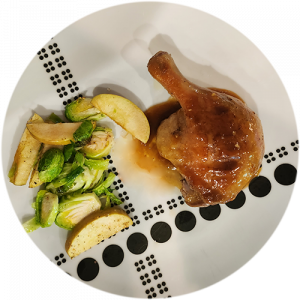 I tried cooking the duck leg in a sous vide bath, finishing it in a hot skillet to get crispy skin. It worked surprisingly well. In the past, I’ve cooked the duck in a medium-low skillet, skin side down, for about twenty minutes to get that crispy skin, then flipped it for five more minutes at high heat. The problem with doing it this way is that you run the risk of the meat being overdone or underdone and/or burned skin. The sous vide method again appears to be fool-proof. I guessed at setting the bath at 150F for two hours, since that’s what works for chicken. It seemed okay here, too.
I tried cooking the duck leg in a sous vide bath, finishing it in a hot skillet to get crispy skin. It worked surprisingly well. In the past, I’ve cooked the duck in a medium-low skillet, skin side down, for about twenty minutes to get that crispy skin, then flipped it for five more minutes at high heat. The problem with doing it this way is that you run the risk of the meat being overdone or underdone and/or burned skin. The sous vide method again appears to be fool-proof. I guessed at setting the bath at 150F for two hours, since that’s what works for chicken. It seemed okay here, too.
I used duck legs tonight. Everything here would also work with duck breasts, except that the sous vide temperature should be lower–130F is the recommended temperature for sous vide duck breast. By the way, the usual temperature guidelines for meat temperatures don’t take into account the longer duration used in sous vide cooking; the extended time means that the lower temperatures will kill any residual bacteria on the meat.
Of course, the sous vide method won’t give you the Maillard reaction, so you need to sear the meat when it comes out of the cooker. It’s better if you don’t use a non-stick pan for searing. When the meat hits a hot stainless steel or wrought iron surface, it initially binds to the pan while the reaction forms. Once it’s properly seared, it releases, which is your signal to turn the meat. If you use a non-stick pan, you don’t get that “release” cue.
The apricot sauce was a variation of traditional Chinese duck sauce–that orange dipping sauce you see in Chinese restaurants. This didn’t turn out orange, but it was pretty tasty. This sauce would be good on chicken, too.
Cous Cous Salad
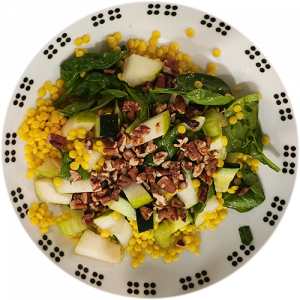 We usually have a fruit salad for the evening meal, but I wanted to try something a little different. The cous cous added carbs and a texture to the salad, and the lime and honey dressing gave a nice, light flavor. The directions make this look hard, but it’s really easy–especially if you omit the toasted nuts.
We usually have a fruit salad for the evening meal, but I wanted to try something a little different. The cous cous added carbs and a texture to the salad, and the lime and honey dressing gave a nice, light flavor. The directions make this look hard, but it’s really easy–especially if you omit the toasted nuts.
Brussels Sprouts and Apples
This is pretty standard fair, and went nicely with the rest of the meal. The first two recipes are pretty long, so I’ll save posting details for later–although its hardly a mystery: slice Brussels sprouts, an apple, toss with olive oil, and roast in a 425F oven for twelve minutes.
 PrintDuck with apricot sauceCourse Main CourseCuisine ChinesePrep Time 15 minutesCook Time 2 hours 20 minutesServings 2EquipmentSous Vide Cooker and bag for cookingPan for searing duck NOT a non-stick pan. Small mixing bowl for sauce A prep bowl, a ramekin, or a coffee mug will do. It just needs to hold one cup of liquid with room to stir it.IngredientsFor Sous Vide Duck1 Duck legsHerbs for sous vide bagSalt and Pepper to tasteFor Sauce1/2 C Apricot jam1 TBSP Soy sauce1 TSP Sweet Chili Sauce2 TBSP Olive Oil2 TBSP Honey1 Clove Garlic Minced (optional)InstructionsSous vide stepBring sous vide bath to 150F. While the bath is heating, prepare the duck.Score the skin of the duck with a sharp knife. The cuts should be roughly half and inch apart, through the skin and into the subcutaneous fat but not into the underlying meat.Salt and pepper the duck. Be liberal with the salt, rubbing into the scores in the skinPlace the duck in your plastic bag. Add any herbs you plan to use. I used thyme and rosemary since I have those growing in my kitchen.Seal the duck and herbs in the bag and place in Sous Vide bath for two hours.SaucePut the ingredients in a small mixing bowl. Mix the ingredients together. I have a mini-whisk I use, but a spoon should work. Finishing the duckWhen the duck has cooked for two hours, it's ready to take out of the sous vide bath. It's perfectly ok to let it run longer, but you don't want to render all the fat out of the duck–you need some there to get that crisply skin. The duck will be medium rare. The temperature and duration of the bath will kill any bacteria.Remove the duck from the bags and discard any herbs still in the bag.Bring a saute pan to medium-high heat.While the pan is heating, dry the duck with paper towels. Wrap the duck in paper towels to soak up any water that's leaked into the bag during the sous vide bath. If it's not dry, you'll get lots of splatter when you put the duck in the saute pan–one of the things to be aware of when you finish sous vide meats on the stove.When the pan is hot–probably about five minutes–add 2TBSP of high-smoke oil like canola oil to the pan. ( To test if the pan is hot, add a drop of water in the pan. It will sizzle and disappear if it's hot.) Don't add the oil until the pan is hot. I don't recommend using olive oil, since it has a lower smoke pointPut the legs in the pan, skin-side down, and let them cook. Expect some splatter, so if you have a splatter guard use it. Let them cook for at least a couple of minutes. If you try to turn them too soon, they will stick to the pan, so wait. They'll release when they ready to turn. That's one reason to not use a non-stick pan for this step.Increase the heat to medium-high and flip the duck. Cook for another minute or until the duck releases from the pan. Remove the duck from the pan and let rest for five minutes on a cutting board. This will keep oily fats leaking onto the plate and spoiling your presentation.To plate the duck, swirl some sauce onto the plate, put the duck on top of the swirl, then spoon more sauce over the duck.
PrintDuck with apricot sauceCourse Main CourseCuisine ChinesePrep Time 15 minutesCook Time 2 hours 20 minutesServings 2EquipmentSous Vide Cooker and bag for cookingPan for searing duck NOT a non-stick pan. Small mixing bowl for sauce A prep bowl, a ramekin, or a coffee mug will do. It just needs to hold one cup of liquid with room to stir it.IngredientsFor Sous Vide Duck1 Duck legsHerbs for sous vide bagSalt and Pepper to tasteFor Sauce1/2 C Apricot jam1 TBSP Soy sauce1 TSP Sweet Chili Sauce2 TBSP Olive Oil2 TBSP Honey1 Clove Garlic Minced (optional)InstructionsSous vide stepBring sous vide bath to 150F. While the bath is heating, prepare the duck.Score the skin of the duck with a sharp knife. The cuts should be roughly half and inch apart, through the skin and into the subcutaneous fat but not into the underlying meat.Salt and pepper the duck. Be liberal with the salt, rubbing into the scores in the skinPlace the duck in your plastic bag. Add any herbs you plan to use. I used thyme and rosemary since I have those growing in my kitchen.Seal the duck and herbs in the bag and place in Sous Vide bath for two hours.SaucePut the ingredients in a small mixing bowl. Mix the ingredients together. I have a mini-whisk I use, but a spoon should work. Finishing the duckWhen the duck has cooked for two hours, it's ready to take out of the sous vide bath. It's perfectly ok to let it run longer, but you don't want to render all the fat out of the duck–you need some there to get that crisply skin. The duck will be medium rare. The temperature and duration of the bath will kill any bacteria.Remove the duck from the bags and discard any herbs still in the bag.Bring a saute pan to medium-high heat.While the pan is heating, dry the duck with paper towels. Wrap the duck in paper towels to soak up any water that's leaked into the bag during the sous vide bath. If it's not dry, you'll get lots of splatter when you put the duck in the saute pan–one of the things to be aware of when you finish sous vide meats on the stove.When the pan is hot–probably about five minutes–add 2TBSP of high-smoke oil like canola oil to the pan. ( To test if the pan is hot, add a drop of water in the pan. It will sizzle and disappear if it's hot.) Don't add the oil until the pan is hot. I don't recommend using olive oil, since it has a lower smoke pointPut the legs in the pan, skin-side down, and let them cook. Expect some splatter, so if you have a splatter guard use it. Let them cook for at least a couple of minutes. If you try to turn them too soon, they will stick to the pan, so wait. They'll release when they ready to turn. That's one reason to not use a non-stick pan for this step.Increase the heat to medium-high and flip the duck. Cook for another minute or until the duck releases from the pan. Remove the duck from the pan and let rest for five minutes on a cutting board. This will keep oily fats leaking onto the plate and spoiling your presentation.To plate the duck, swirl some sauce onto the plate, put the duck on top of the swirl, then spoon more sauce over the duck.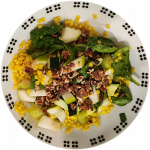 PrintCous Cous Salad with Pears, Cucumber, and CeleryCourse SaladPrep Time 10 minutesServings 4IngredientsDressing4 TBSP Olive Oil2 TBSP Lime juice plus zest of one lime1 TBSP Sesame oil2 TBSP Honey1 garlic clove, minced (optional)Salt and pepper to tasteSalad1/4 C loosely chopped nuts–I used pecans, but walnuts would work1 Pear, cored, and cut in quarter inch dice1 Small cucumber, cut into quarter inch dice2 stalks celery, cut into quarter inch slices1 C Pearl cous cous1/2 C Spinach1 C waterInstructionsDressingMince the garlic, if using. I used a garlic press, so I get the flesh of the garlic without the fibers. IAdd all the ingredients to a prep bowl and mix. Adjust salt, pepper, and more honey to taste.SaladPreheat oven to 350FLine small cookie sheet with parchment paper (NOT waxed paper, unless you want to practice with your fire extinguisher!)add lightly chopped nuts to cookie sheet. Place in oven for five to ten minutes, tossing once. Let cool on small plate.Bring one cup of water to boilRemove water from heat and add one cup of cous cous. Cover and let sit for five minutes. While it sits, continue with the recipe. You can do this step a day ahead.Core the pear and cut in quarter inch dice. One pear is enough for two big salads.Cut enough cucumber into quarter inch dice so that you have, by volume, the same as the pears. Cut the celery into quarter-inch slices, adjusting the number of stalks so you have about the same volume as the pears.Place the pear, cucumber, celery, and spinach in salad bowl.Fluff the cous cous–assuming five minutes have passed! If the cous cous is hot, rinse under cold water in a colander. Once cool, add it to the bowl with the other ingredients and toss.Add the dressing to taste. You should have enough dressing for four salads, so if you're cooking for two, you can save this in the refrigerator for at least a week.
PrintCous Cous Salad with Pears, Cucumber, and CeleryCourse SaladPrep Time 10 minutesServings 4IngredientsDressing4 TBSP Olive Oil2 TBSP Lime juice plus zest of one lime1 TBSP Sesame oil2 TBSP Honey1 garlic clove, minced (optional)Salt and pepper to tasteSalad1/4 C loosely chopped nuts–I used pecans, but walnuts would work1 Pear, cored, and cut in quarter inch dice1 Small cucumber, cut into quarter inch dice2 stalks celery, cut into quarter inch slices1 C Pearl cous cous1/2 C Spinach1 C waterInstructionsDressingMince the garlic, if using. I used a garlic press, so I get the flesh of the garlic without the fibers. IAdd all the ingredients to a prep bowl and mix. Adjust salt, pepper, and more honey to taste.SaladPreheat oven to 350FLine small cookie sheet with parchment paper (NOT waxed paper, unless you want to practice with your fire extinguisher!)add lightly chopped nuts to cookie sheet. Place in oven for five to ten minutes, tossing once. Let cool on small plate.Bring one cup of water to boilRemove water from heat and add one cup of cous cous. Cover and let sit for five minutes. While it sits, continue with the recipe. You can do this step a day ahead.Core the pear and cut in quarter inch dice. One pear is enough for two big salads.Cut enough cucumber into quarter inch dice so that you have, by volume, the same as the pears. Cut the celery into quarter-inch slices, adjusting the number of stalks so you have about the same volume as the pears.Place the pear, cucumber, celery, and spinach in salad bowl.Fluff the cous cous–assuming five minutes have passed! If the cous cous is hot, rinse under cold water in a colander. Once cool, add it to the bowl with the other ingredients and toss.Add the dressing to taste. You should have enough dressing for four salads, so if you're cooking for two, you can save this in the refrigerator for at least a week.The post What’s For Dinner first appeared on Max Griffin.
May 4, 2023
What’s for Dinner
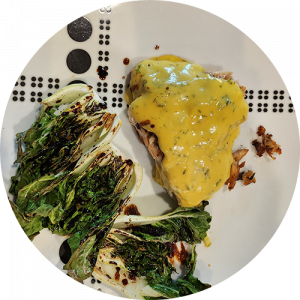 At the grocery store yesterday I picked up a couple of swordfish steaks. So, last night’s dinner started with sous vide swordfish. I had some baby bok choi left over, so that was the vegetable course. I finished with a fruit salad that included watermelon, strawberries, plums, and bananas. I made a honey-garlic sauce for the bok choi and the easy Bearnaise sauce I’d posted a few days ago for the swordfish.
At the grocery store yesterday I picked up a couple of swordfish steaks. So, last night’s dinner started with sous vide swordfish. I had some baby bok choi left over, so that was the vegetable course. I finished with a fruit salad that included watermelon, strawberries, plums, and bananas. I made a honey-garlic sauce for the bok choi and the easy Bearnaise sauce I’d posted a few days ago for the swordfish.
To sous vide the swordfish, I seasoned them first with salt and pepper and put them in two (unsealed) plastic bags. I zested one lemon for each steak and put the zest in the bag with the fish. Then I squeezed the lemons and added the lemon juice to the bag. Finally, I added 1TBSP of garlic-infused olive oil to the bags and sealed them. I cooked them for thirty minutes with my sous vide cooker set at 130F. When they were done, I took them from the bags, dried them on paper towels, and let them rest for a couple of minutes. While they rested, I heated a grill pan on my cooktop. When it was hot, I basted the steaks with garlic-infused olive oil and seared them for one minute on each side. That gave them nice grill marks and was enough for the Maillard reaction. (In the photo, the Bearnaise sauce hides the grill marks.)
If you’re unfamiliar with sous vide, I suppose I should link to where you can learn more about it.
To infuse the oil, I used my ISI food whip. It’s great for making whipped cream, too.
The new item tonight is the honey-garlic sauce i put on the bok choi. I’ve used this before, but I don’t think I’ve posted the recipe, so here it is. It’s pretty sticky and pretty sweet, but really tasty. I kind of wish I’d used it on the swordfish, too, although the Bearnaise sauce was good.
The recipe calls for diced garlic, but I used a garlic press instead. You can find the one I used on Amazon; it’s really good.
. [image error][image error]
PrintHoney Garlic Soy SauceEasy, sweet, stickyCourse SauceCuisine ChinesePrep Time 15 minutesEquipment1 sauce panIngredients1/4 C Soy Sauce1./4 C Honey1 TBSP Rice vinegar1 TBSP Olive Oil 2 Cloves Garlic, diced1 TSP Fresh grated ginger1/4 C Chicken broth1 TBSP Corn Starch2 TBSP Chicken broth (or white wine)InstructionsApply low heat to a small sauce pan. Allow at least 3 minutes for the pan to heat up.Add the olive oil, diced garlic, and grated ginger to the sauce pan. Stir until fragrant, about one minuteAdd 1/4 C of broth, 1/4 C of soy sauce, 1/4 C of honey to sauce pan and heat for a couple of minutes, whisking to mixMake a slurry of 1TPSP corn starch and 2TBPS of broth (or white wine–I used an inexpensive Riesling)Whisk the slurry into the heated sauce mixture. Continue whisking until sauce thickens. This should take about a minute. Sauce will get thicker as it cools.Remove from heat and use at once or refrigerate for up to two weeks. If you refrigerate, bring to room temperature before using. NotesInstead of corn starch, you could use xanthum gum as a thickener. This doesn’t require heating, but does require a hand-infusion blender to properly mix the ingredients. A little xanthum gum goes a long way, so don’t use more than a quarter teaspoon.
The post What’s for Dinner first appeared on Max Griffin.
April 29, 2023
No Book Is an Island
A colleague of mine recently got a response from an editor praising his story for being “almost metatextual.” He wondered what that meant. I wondered, too. So, I went to trusty old Widkipedia and found this:
Metatextuality is a form of intertextual discourse in which one text makes critical commentary on itself or another text.
Like that was helpful. Not.
I know what “metadata” is. It’s “data about data.” For a phone call, for example, metadata might include the phone numbers, the location of those numbers, the duration of the call, or the service provider. It might also include the names of the callers, and whether or not there is court-approved surveillance of one of the phone numbers, i.e., a wiretap. But “meta-data” does not include the topic of conversation: it’s not a wiretap. It’s data about the call, not the call itself.
So, by analogy, “metatext” must be text about text. Just like Wikipedia said. Or not.
Anyway, for an easy example, think about Mary Shelley’s Frankenstein. The title page of the 1818 edition includes a passage from Milton’s Paradise Lost. a bit of text that’s about the story that people are going to read: That makes it metatext. It alerts the reader that this novel is about life, death, creation, and religion. Anytime an author uses quotes as headers—including made-up quotes—they are metatextual comments on the fictional content.
But it’s deeper than just quotes that stand outside the novel. The first American haunted house appears in Poe’s “The Fall of the House of Usher.” The story features a failed artist and a haunted house that destroys him, his family, and his art with false promises of immortality. The house becomes a malevolent character in the story. But wait. Doesn’t that basically describe the plot of the The Shining? Indeed, many critics have noticed the links, the metatextual links, between the two works. There are even places where King paraphrases Poe’s story. That makes King’s work metatextual both in structure and in detail.
Another way that text can be referential is the story-within-a-story. In Hamlet, for example, the eponymous prince stages a play in which the principals re-enact the murder of his father. The play-within-a-play form of metatext is pervasive, especially in cinema. Singing in the Rain is a movie about making a movie. Innumerable Andy Rooney and Judy Garland movies involve putting on shows. White Christmas is a movie about a show. Christopher Nolan’s Inception is a multilayered sequence of dreams, each a metatextual commentary on the characters that ultimately leave the audience to wonder if anything was really real. Poe’s “All that we see or seem is but a dream within a dream” could be metatext for Nolan’s masterpiece.
Genres can have common elements that, when deployed by authors, become metatextual, providing context for the readers and helping to stimulate their imaginations. Haunted houses hearken back to Poe. Detectives hearken back to Poe, too, but also to Dashiell Hammett, Raymond Chandler, Agatha Christie, or many others. Indeed, the nature of the detective is metatext—a detective like Sam Spade signals a different kind of story from one featuring a detective like Miss Marple.
Characters in fiction live in the real world. In modern-day fiction, they watch TV, listen to music, and read books. What they watch, listen to, and read becomes metatext for the events of the novel. “The Devil went Down to Georgia,” and “Country Roads” both could be metatextual, albeit with different commentaries on main text. Iconic phrases, like Star Wars’ “I’ve got a bad feeling about this…”, can also be deployed as metatext.
Metatext can also be humorous. Commercials that feature characters in horror movies “choosing badly” provide humorous metatext for buying insurance.
The title for this essay, a riff on John Donne’s famous poem, serves as metatext for its content.
Sometimes metatext can be as simple as the author’s name.
During the 1950’s, numerous Hollywood artists had been blacklisted by the Hollywood studios, most for refusing to “name names” before the infamous McCarthy committee. One of these was Dalton Turmble, who, after being blacklisted, managed to make a living by ghost-writing scripts. Some of these, like the one for Roman Holiday, wound up winning Academy Awards for which he did not receive credit. When Kirk Douglas decided to produce Spartacus in 1960, he hired Trumble to write the screenplay. Douglas used his own company to produce the film, and decided to give Trujmble screen credit. This resulted in considerable negative publicity during the pre-release of the film, especially from the conservative press. But Douglas was adamant, and Trumble’s name stayed in the credits.
That screen credit is metatext for the most powerful scene in the movie.
In that scene, the Roman general Crassus has just defeated and taken prisoner Spartacus and his army of slaves. Crassus demands the prisoners, on the pain of death, identify Spartacus. First one person, then many, then the entire army responds, “I am Spartacus.” Trumble’s name in the credits gives special meaning and power to this scene. It came to stand for the artists of Hollywood, led by Douglas, standing up to the Blacklist. This movie, and the response to it, ended the practice of blacklisting.
Metatext has power.
Metatext is everywhere. Authors use it all the time, often without thinking about it. It can arise in the haze that’s part of the creative process, or it can be a deliberate addition after the fact. Metatext deploys the fact that no reader is an island. Our readers, like us, swim in an ocean filled with cultural and emotional references, just waiting for metatext to call them out.
The post No Book Is an Island first appeared on Max Griffin.
April 27, 2023
Movie Review
Have ever watched a movie that was so good you couldn’t wait to tell other people about it? I certainly have, but this post is kind of the opposite. I just watched a movie that I found so disappointing that I have to warn people about it.
The movie is Don’t Worry Darling.
Don’t get me wrong. It’s at least possible to watch this movie and enjoy it for the many good things it does. But at the end, if you’re like me, you’ll come away feeling like you’ve spent two hours nibbling at hamburger helper dressed up to look like beef bourguignon.
This movie had so much promise and, in fact, there is much to love about it. To start with, it’s directed by Olivia Wilde, who also appears in the movie and is one of the producers. Her performance is stellar, as always. Indeed, all the performances are solid, which speaks to her direction as well. The movie has stunning mid-century sets that perfectly capture the tone of the era. It even features the famous Kauffman Desert Home designed by Richard Neutra, a classic of mid-century modern design. The costumes and makeup follow the same pattern, perfectly setting the tone. Likewise, the pacing and tension are tightly wound, and the camera work and cutting accentuate this.
The score perfectly pairs period music with the action and would be worth an essay all by itself. A few examples will suffice. Early in the movie, Peggy Lee sings “Where or When” accompanied by the Benny Goodman Quartet. The lyrics by Frank Sinatra and Dean Martin chillingly foreshadow future events in the story. Later, Harry Styles channels Fred Astaire to the relentless beat of “Sing, Sing, Sing (With a Swing)” performed by James Horner. This scene—which felt a bit overlong, although I enjoyed the music and the dancing–shows the men of movie equally under the thrall of the controlling evil mastermind, ably played by Chris Pine. Toward the end of the movie, Ella Fitzgerald sings the Gershwin classic “Someone to Watch Over Me.” It’s not precisely of the era, but the nostalgic yearning of the piece stands in ironic contrast with events on the screen.
The premise of the movie is promising, too. The idea apparently was to do a modern-day take on the The Stepford Wives” that combines ideas from The Matrix or The Thirteenth Floor. Great idea, especially in our post-Roe-v-Wade world, where book-banning and minority scape-goating are again ascendant. The movie reflects both the current and past when the sole African-American cast member is murdered for speaking out.
So, with so much good going for it, what went wrong? Things were going pretty well, if a bit predictably, until about two-thirds of the way through the movie, when the narrative thread untangles and never recovers.
The movie is set in a 50’s-style development that’s isolated in the desert. Somewhat like Pleasantville, everyone lives in isolation in this re-creation of 50’s bliss, with no escape. However, every morning the men all depart to work on “The Project” at a place hidden away on a remote mountaintop. At the start of act three—about three-quarters of the way through the movie—one of the wives, played brilliantly by Florence Pugh, goes to the mountain top and beats on the door. The camera fades, and we know that we’ll finally learn The Secret of the town.
If you want to watch the movie, I’m about to give away The Secret. It’s not much of a Secret, though, so you won’t lose much if you read on. I mean, it’s been obvious for ninety minutes or so that this is going to be a variation on “The Stepford Wives,” so how surprising can it be?
Anyway, the camera fades back in on that same wife, except she’s now working as a surgeon in an operating room. She’s at the end of an eighteen-hour shift. She’s tired. She trudges home through a thoroughly modern-day and dismal city to her rundown apartment. Once there, she meets her loser husband who plays video games all day and whines about her never being home. That’s the same husband, played by Harry Styles, that we’ve been seeing for the first ninety minutes of the movie, busily going off every morning to work.
Wait. The last time we saw her, she was in the desert pounding on the door to the The Project, where all the men go to work. How did she get to today, to a hospital, and to a crappy apartment?
The scene continues, and we see the loser husband drug her, put patches on her eyes—think Clockwork Orange. He then he climbs into bed next her and puts patches on his eyes. Fade out.
Fade back in, and she’s back in her mid-century housing addition, this time gushing over children that were only hoped-for earlier in the movie.
So, what just happened? Logically, we’ve seen what happened when she pounded on the door to The Project. But in the present, as a surgeon, she clearly has no memory of the desert community. So, the stuff in the present day that we just watched, where she’s a surgeon, must have been a flash-back, revealing that she’s been vegging out with her husband in a forced, drugged stupor, mutually hallucinating the first ninety minutes of the movie. This explains what’s really been going on. That’s The Secret.
Now, I don’t mind flashbacks, but the key is the transition from the here-and-now of the story to the past and back again. If that’s not clear, you lose your audience. The problem is that everything on the screen suggests that the events in the present-day happened between her pounding on the door and waking up back in the subdivision. That makes zero sense in terms of the narrative, so it must have been a flashback. But that’s exactly where the narrative thread unravels, because you have to stop and think about it. You’re still thinking about it as events unfold, trying to fit what just happened with what’s happening on the screen right now. It’s an enormous distraction.
For contrast, consider Mulholland Drive. The first half of this movie is all a dream, and we transition to Betty’s here-and-now after the “LLorando” song in the middle of the movie. But it’s not quite the entire first half of the movie that’s a dream. There’s a brief segment at the very beginning, that shows a haggard Betty, surrounded by drug paraphernalia, on a sofa in a sleazy apartment. That short scene fades to a perky Betty arriving in LA and her rosy dream about what she wished her life had been. Two hours later, the movie ends back in that sleazy apartment with Betty’s overdose, closing the loop. That’s brilliant storytelling, without the puzzling transitions that disrupt the visual experience.
Instead, in Don’t Worry Darling, we have this out-of-order sequence that’s in the present-day that the movie fits sequentially between her pounding on the door and waking up later in the subdivision. However, it only makes sense as a flashback, despite what the action on the screen suggests. That one scene essentially breaks the narrative and the willing suspension of disbelief that’s necessary to experience the movie.
Another problem with this is that it dissipates a good deal of the later suspense in the movie. There’s a harrowing car chase sequence, for example. Ordinarily this would be breath-taking, except if everything is a simulation it doesn’t matter if there’s a car crash. After all, they’re just all hallucinations or in a drugged stupor in some apartment someplace. Then there’s heroine’s struggle to get back to the “The Project” and escape. But apparently nothing happened the first time she got there, so who cares? If something did happen, it landed her trapped back in the project, so the whole escape sequence makes zero sense.
To be sure, they try to “fix” this with some snippets of dialogue, but even if those offer a credible explanation—they don’t–that just makes it worse and further degrades the fictional dream that should be running the viewer’s head while watching the movie. If you have to use dialogue to explain what’s happening on the screen, you’ve missed the point of a visual medium.
If the movie had been recut along the lines of Mullholland Drive, it might have worked—who knows? But at least it would have had a coherent narrative, which this one does not.
That raises the question how could this have gone so wrong with so much talent on display? It’s tempting to blame the editor, except that he’s got a distinguished record with many nominations and several awards for editing. Olivia Wilde’s direction is awesome. Likewise, the screenwriters have credible records. I think the answer might be in the “Produced by” credits, which lists eleven producers, including no fewer than six executive producers. I wonder if all those executives couldn’t agree on where to put this essential framing sequence and compromise led to the worst possible placement.
I enjoyed many things in this movie. I enjoyed them so much that the failure in story-telling was more disappointing that might have been the case in a lesser movie. Maybe they’ll recut it someday. One can hope.
The post Movie Review first appeared on Max Griffin.
April 18, 2023
What’s For Dinner
April 18, 2023
Sous vide salmon, Bearnaise sauce, and roasted baby bok choy
I wanted 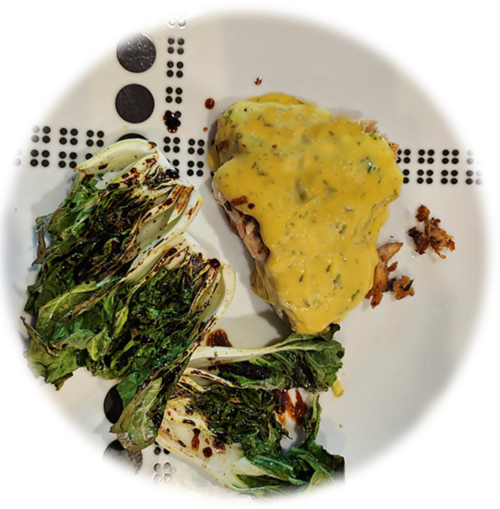 something easy on a Tuesday night, so I decided to sous vide a couple of salmon filets for the main course. Sous vide is so easy. This time, I bagged the salmon fillets separately because the fish proteins are more delicate than chicken, beef, or pork and if you put two fillets in one bag, they will kind of dissolve into one big filet. So, two bags, set at 115F for 60 minutes.
something easy on a Tuesday night, so I decided to sous vide a couple of salmon filets for the main course. Sous vide is so easy. This time, I bagged the salmon fillets separately because the fish proteins are more delicate than chicken, beef, or pork and if you put two fillets in one bag, they will kind of dissolve into one big filet. So, two bags, set at 115F for 60 minutes.
Of course, I wanted to sear them once they came out of the sous vide bag. I’d just gotten my new Anolon Nouvelle cookware 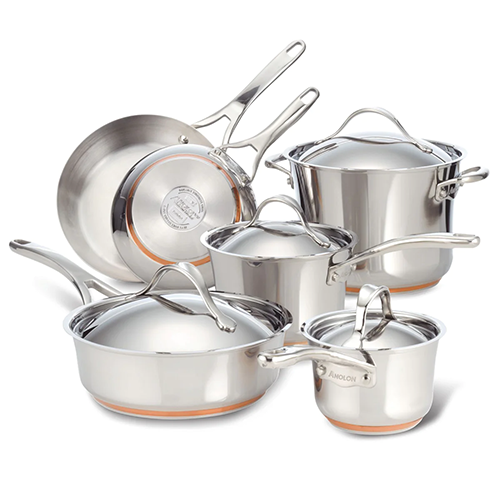 this morning, so this was my first chance to use it. I worked out pretty well, although this was my first time using stainless steel cookware, so it wasn’t perfect. I got the pan too hot, and then tried to flip the fillets too soon and one of them came apart. Still, they got a good sear on them and they tasted great. Clean-up was easy, even without the non-stick coating.
this morning, so this was my first chance to use it. I worked out pretty well, although this was my first time using stainless steel cookware, so it wasn’t perfect. I got the pan too hot, and then tried to flip the fillets too soon and one of them came apart. Still, they got a good sear on them and they tasted great. Clean-up was easy, even without the non-stick coating.
 I also went to the new Pan-Asian grocery store in Tulsa where I got baby bok choi among other supplies not available at the neighborhood Reasors. Anyway, I roasted a couple of them for sides, and then basted them with a sweet sauce made from soy sauce, sesame oil, balsamic vinegar, and honey.
I also went to the new Pan-Asian grocery store in Tulsa where I got baby bok choi among other supplies not available at the neighborhood Reasors. Anyway, I roasted a couple of them for sides, and then basted them with a sweet sauce made from soy sauce, sesame oil, balsamic vinegar, and honey.
Gene doesn’t like salmon, so I always try to add a sauce to bring him along. Bearnaise sauce is great with salmon but…well…it’s Bearnaise sauce, and notoriously hard to fix. I’ve made it before, and it usually turns out ok, but not always. Besides, it’s time consuming, involves an eternity of whisking, and, well, I wanted something easy.
So, off to Google looking for easy Bearnaise sauce. I found a recipe on RecipeTinEats, a website that consistently has flavorful and clear recipes. Their recipe for Bearnaise sauce used a hand-infuser to mix the clarified butter, herb-infused vinegar, and egg yolks, a process that took about two minutes as opposed to the ten minutes or more for the conventional double-boiler and whisk method. I even followed her advice and used some Ghee that I picked up at the Pan-Asian store instead of clarifying my own butter. It was easy and came out perfect.
The main shortcut in this recipe involves the hand-infuser. In the traditional method, you put your egg yolks and infused vinegar in a double-boiler, then gradually add bits of butter, whisking away all the time. The heat from the double-boiler cooks the yolks while melting the butter, and the whisking infuses the yolks, melted butter, and vinegar. But if your timing is even a little bit off, you can get scrambled eggs or a sauce that’s split instead of infused.
The RecipeTinEats method uses melted butter to cook the eggs, so it kind of reverses the normal process but gives the same result. A minute in the microwave under medium heat, and the butter is hot enough to cook the eggs. You still have to gradually add the melted butter to the yolks while the hand-infuser is running, but it’s the same reaction, consistency, and flavor.
Even Gene liked it.
I’ve taken this recipe almost verbatim from the one linked above.
PrintEasy Bearnaise SauceCourse SaucePrep Time 15 minutesCook Time 2 minutesEquipment1 Hand infuser1 Wire mesh strainerIngredientsInfused vinegar1.5 TBSP White wine1.5 TBSP White wine vinegar1 shallot, finely sliced2 TSP dried TarragonBearnaise Sauce2 Egg yolks3/4 C Ghee (or 1 stick of butter)1.5 TSP Infused vinegar1 TSP dried tarragon1/2 TSP Cherval (I used fresh thyme)InstructionsInfuse the vinegarPlace all the ingredients in a small sauce pan and bring to simmer. Simmer for at least two minutes while stirring until it is reduced by half.Let cool for at least ten minutes, then strain out the vinegar and dispose of the solids. You should have about 1.5 TBSP.Bearnaise SaucePlace the ghee in a micro-wave mug (not plastic!), and heat at medium for one minute.If using butter instead of ghee, cut one stick up into small pieces and melt in 20-second increments for about 90 seconds. Let it sit for about 30 seconds, and milk solids will settle in the bottom. The part that's on top is (more or less) clarified butter,and that's what you'll use to make the sauce. Pour the top part into a measuring cup and discard the solids. The milk solids have already been removed from the ghee. While ghee is heating, add two egg yolks to a tall coffee mug and add the infused vinegar.With the hand-infuser, give the yolks and vinegar mixture a whiz to mix them up. Then, with the infuser running, slowly pour the ghee into yolks. Take at least a couple of minutes to pour all the ghee into the yolk mixture, moving the infuser up and down to make sure it's all mixed.The result will be quite thick. You may want to thin it with a TBSP of water at a time. Remember, you can make a thick sauce thinner, but can't make a thin sauce thicker! I just took the thick sauce with no thinning.At the end, stir the herbs into the sauce, and you're good to go.NotesYou can't reheat this, since it will separate. What you could do is prepare this in advance and store it in a thermos, where it should stay warm for at least and hour.I didn't have fresh tarragon, so I used the dried herbs I had on hand. I substituted thyme for chervil since I did have that fresh.I used a cappuccino coffee cup to do the infusion. It's important that your hand infuser make good contact with the bottom of whatever you use to do the infusion so that you create a vortex of the ingredients, making the infusion.I wound up with enough sauce for four fillets. Alas, it won't store.This recipe is taken more or less verbatim from the RecipeTinEats website.
The post What’s For Dinner first appeared on Max Griffin.
April 16, 2023
What’s For Dinner
Sunday, April 16, 2023
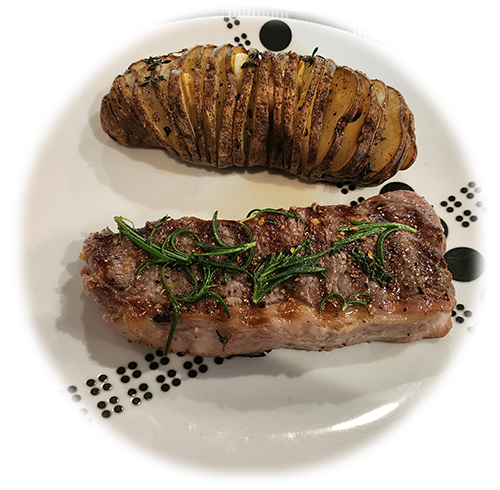 The main course for dinner tonight is New York strip steak with Hasselback potatoes. For Gene’s steak, I’ll be using a sous vide cooker to get it medium-well done; for my steak, I’ll just sear it in the pan. The Hasselback potatoes go in the oven.
The main course for dinner tonight is New York strip steak with Hasselback potatoes. For Gene’s steak, I’ll be using a sous vide cooker to get it medium-well done; for my steak, I’ll just sear it in the pan. The Hasselback potatoes go in the oven.
The star of tonight’s dinner is the dessert, a raspberry cream pie. For that, I use a cookie crumb crust, cream cheese, and whipped cream. The crust recipe is based on one I found on Williams Sonoma, while the filling is from Mom With Cookies.
The recipe for the sous vide steak is hardly a recipe at all. You set the cooker to 145F, seal the steak and seasonings in a baggie, drop the baggie in the sous vide bath, and in a couple of hours you’re done. I used salt, pepper, fresh rosemary and thyme for the seasonings. Once done, you remove the steak from the bag, dry it off, and then sear it in a hot pan get the Maillard reaction. For my steak, all I did was sear it with herbs, which gives me a perfect rare steak.
 Potato Prep
Potato PrepHasselback potatoes look super-fancy and taste awesome, but they are easy to fix–barely more difficult than the traditional wrapped-in-foil baked potato. The idea is that you make slices about 1/8 to 1/4 inch apart that go almost-but-not-quite all the way through the potato. You can purchase a guide from Amazon to assist in getting evenly spaced slices. If you put the potato on on wooden spoon, that will keep you from slicng all the way through the potato. Slicing two potatoes takes maybe five minutes.
Once sliced melt some butter and olive oil (maybe 2TBSP of each), and baste the potatoes; save about 1/2 of your butter/oil mixture for later. I usually cut 3-4 cloves of garlic into thin slices and stick them between the potato slices at this time to infuse the garlic flavor into the potato while cooking. Put the potatoes on a roasting pan and bake them in a 420F oven for roughly an hour. After about 45 minutes, the slices will separate, so that’s a good time to pull them out, use the rest of your butter/oil mixture to baste them again so it gets between the slices. This is also the time to add other herbs as well. I used fresh thyme since I had it.
I used russet potatoes because that’s what I had on hand. Usually, I use red potatoes since they are smaller and “waxier.” When the potatoes are done, you’ve got an impressive-looking side dish that tastes awesome. The tips of the potatoes are crispy like French fries, while the interiors are soft like a baked potato.
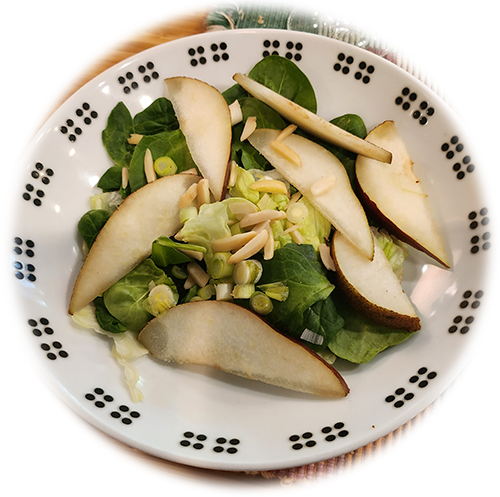 We also had a green salad with baby spinach, iceberg lettuce, chives, slivered almonds, and thinly sliced pears.
We also had a green salad with baby spinach, iceberg lettuce, chives, slivered almonds, and thinly sliced pears.
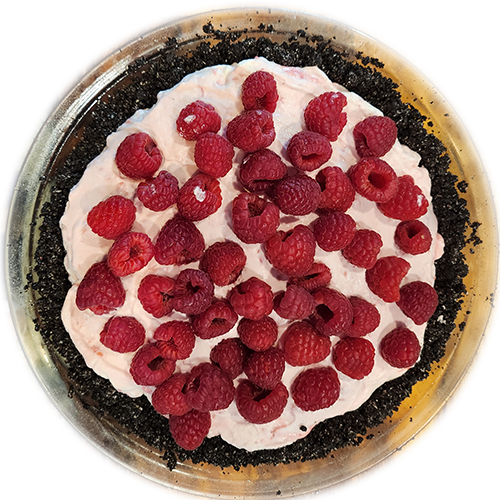 But the star of tonight’s dinner is the dessert: raspberry cream pie with a chocolate cookie crumb crust.
But the star of tonight’s dinner is the dessert: raspberry cream pie with a chocolate cookie crumb crust.
When I looked for recipes on chocolate cookie crumb crusts, I found tons. Most of them started with 24 Oreo cookies. After that, they split in half. One half just dumped the cookies, filling and all, into a blender and used the result as the basis for the crust. That means that you get all that extra yucky lard (the filling) in your crust. Now, don’t get me wrong. I love Oreo double-stuff cookies, but not in my pie crust. The other half laboriously separated the cookies and filling, discarded the filling (ordinarily the best part), and used the blender to crumble the rest.
However, you can purchase chocolate cookie crumbs from Nabisco. No need for blender, no lardy filling to discard or to clog your crust. Or, you could purchase chocolate graham crackers, put those in your blender, and get chocolate cookie crumbs that way. I chose the easy way and got the Nabisco chocolate cookie crumbs via Amazon. I use them in my chocolate chiffon cake too. (I’ll post the recipe for that later.)
 PrintChocolate Cookie Crumb Crust#wprm-recipe-rating-0 .wprm-rating-star.wprm-rating-star-full svg * { fill: #343434; }#wprm-recipe-rating-0 .wprm-rating-star.wprm-rating-star-33 svg * { fill: url(#wprm-recipe-rating-0-33); }#wprm-recipe-rating-0 .wprm-rating-star.wprm-rating-star-50 svg * { fill: url(#wprm-recipe-rating-0-50); }#wprm-recipe-rating-0 .wprm-rating-star.wprm-rating-star-66 svg * { fill: url(#wprm-recipe-rating-0-66); }linearGradient#wprm-recipe-rating-0-33 stop { stop-color: #343434; }linearGradient#wprm-recipe-rating-0-50 stop { stop-color: #343434; }linearGradient#wprm-recipe-rating-0-66 stop { stop-color: #343434; }Cookie crumb crust for a cream pieCourse DessertPrep Time 10 minutesCook Time 7 minutesEquipment1 ten inch pie plateIngredients1.5 C Chocolate cookie crumbs1/3 C Sugar (I used splenda)6-7 TBSP Melted butter dash Salt (not needed if using salted butter)Instructionspre-heat oven to 350FMix together cookie crumbs, sugar, and salt if usingMelt butter in microwaveDrizzle butter into sugar/cookie mixture in thirds, mixing with a spatula in between additions. Don't add the butter all at once–it will clump up in the cookie/sugar mixture and you won't be able to properly mix it in.Dump the mix of butter, cookie crumbs, and sugar into a 10 inch pie pan. use your fingers to press it down and start to force it up the sides of the pan.Use a flat-bottomed measuring cup to press the crust into the plate and form up the sides. I used a 1/2C measuring cup, but a small glass would work fine, too. You just need something with a flat bottom that you can use to push the crust into the plate–especially the crust on the sides.Bake for 5-10 minutes to set the crust. Five minutes is the minimum; the longer times give you a progressively crispy crust. For this dessert, I baked mine for seven minutes, which seemed to be about right.Cool to at least room temperature before assembling the pie. If it will be more than an hour before you use it, cover it with plastic wrap and refrigerate. NotesYou could use this same recipe for other cookie crumb pies–graham crackers, ginger snaps, etc. Just start with a baked cookie, crumble it in a blender, the proceed with the recipe. Hmmm…I wonder what a snicker doodle crust would be like?Despite all the butter, this crust can sometimes stick. I’m not a fan of sprays like PAM, but you could line your pie plate with parchment paper for easy removal.
PrintChocolate Cookie Crumb Crust#wprm-recipe-rating-0 .wprm-rating-star.wprm-rating-star-full svg * { fill: #343434; }#wprm-recipe-rating-0 .wprm-rating-star.wprm-rating-star-33 svg * { fill: url(#wprm-recipe-rating-0-33); }#wprm-recipe-rating-0 .wprm-rating-star.wprm-rating-star-50 svg * { fill: url(#wprm-recipe-rating-0-50); }#wprm-recipe-rating-0 .wprm-rating-star.wprm-rating-star-66 svg * { fill: url(#wprm-recipe-rating-0-66); }linearGradient#wprm-recipe-rating-0-33 stop { stop-color: #343434; }linearGradient#wprm-recipe-rating-0-50 stop { stop-color: #343434; }linearGradient#wprm-recipe-rating-0-66 stop { stop-color: #343434; }Cookie crumb crust for a cream pieCourse DessertPrep Time 10 minutesCook Time 7 minutesEquipment1 ten inch pie plateIngredients1.5 C Chocolate cookie crumbs1/3 C Sugar (I used splenda)6-7 TBSP Melted butter dash Salt (not needed if using salted butter)Instructionspre-heat oven to 350FMix together cookie crumbs, sugar, and salt if usingMelt butter in microwaveDrizzle butter into sugar/cookie mixture in thirds, mixing with a spatula in between additions. Don't add the butter all at once–it will clump up in the cookie/sugar mixture and you won't be able to properly mix it in.Dump the mix of butter, cookie crumbs, and sugar into a 10 inch pie pan. use your fingers to press it down and start to force it up the sides of the pan.Use a flat-bottomed measuring cup to press the crust into the plate and form up the sides. I used a 1/2C measuring cup, but a small glass would work fine, too. You just need something with a flat bottom that you can use to push the crust into the plate–especially the crust on the sides.Bake for 5-10 minutes to set the crust. Five minutes is the minimum; the longer times give you a progressively crispy crust. For this dessert, I baked mine for seven minutes, which seemed to be about right.Cool to at least room temperature before assembling the pie. If it will be more than an hour before you use it, cover it with plastic wrap and refrigerate. NotesYou could use this same recipe for other cookie crumb pies–graham crackers, ginger snaps, etc. Just start with a baked cookie, crumble it in a blender, the proceed with the recipe. Hmmm…I wonder what a snicker doodle crust would be like?Despite all the butter, this crust can sometimes stick. I’m not a fan of sprays like PAM, but you could line your pie plate with parchment paper for easy removal. PrintRaspberry Cream Pie#wprm-recipe-rating-1 .wprm-rating-star.wprm-rating-star-full svg * { fill: #343434; }#wprm-recipe-rating-1 .wprm-rating-star.wprm-rating-star-33 svg * { fill: url(#wprm-recipe-rating-1-33); }#wprm-recipe-rating-1 .wprm-rating-star.wprm-rating-star-50 svg * { fill: url(#wprm-recipe-rating-1-50); }#wprm-recipe-rating-1 .wprm-rating-star.wprm-rating-star-66 svg * { fill: url(#wprm-recipe-rating-1-66); }linearGradient#wprm-recipe-rating-1-33 stop { stop-color: #343434; }linearGradient#wprm-recipe-rating-1-50 stop { stop-color: #343434; }linearGradient#wprm-recipe-rating-1-66 stop { stop-color: #343434; }Course DessertPrep Time 30 minutesEquipment1 ten inch chocolate cookie crumb pie crust Graham cracker crust works, too, but the chocolate goes well with the raspberries.1 Optional: wire mesh strainerIngredients12 oz fresh raspberries, divided8 oz cream cheese1 TSP Lemon juice optional1/3 C granulated sugar1 C heavy whipping cream1 TBSP powdered sugar1/2 TSP vanillaInstructionsBring the cream cheese to room temperature, then whip for 2-3 minutes in stand mixer with whiskAdd sugar and 6oz of raspberries to small saucepan and apply low heatUse wooden spoon to stir the berries and sugar, crushing the berries with the back of your spoon. Simmer for 3-4 minutes until mixed.Optional: most recipes say to strain the seeds out of berries. Note that the seeds contain many healthy nutrients, so if you strain them out you are throwing away some of the benefits of the berries. I did not strain my berries, and my pie turned out fine. Strain them if they upset your stomach, get in your dentures, or you don't like the texture of cream filling–it is slightly grainy with the seeds still in it. Optional: add a teaspoon of lemon juice to the berry mixture. This can help bring out the flavor of the fruit.Pour berry/sugar mixture into the cream cheese. Whip for 3-4 minutes until thoroughly mixed and uniform pink in color.While the berries and cream cheese mix, put the heavy cream, powdered sugar, and vanilla in a chilled metal bowl and whip to stiff peaks. (Chilled bowls work best when whipping cream.)Fold the cream cheese/berry mixture into the whipped cream. Shoot for about a dozen folds to get the two mixed together. Over-folding can cause the whipped cream to collapse, so be careful!Use a spatula to place the final mixture in your cooked pie shell and smooth out the filling. Top with the remaining 6 oz of raspberries. Cover and refrigerate until ready to use. You can do this a day ahead if needed.NotesFrozen raspberries would work, too, but thaw them out first. The frozen berries also wouldn’t look as good as the fresh ones to top the pie, so if using frozen berries, you might consider chocolate curls to top the pie instead of berries. At some point, I’ll post how to make chocolate curls…
PrintRaspberry Cream Pie#wprm-recipe-rating-1 .wprm-rating-star.wprm-rating-star-full svg * { fill: #343434; }#wprm-recipe-rating-1 .wprm-rating-star.wprm-rating-star-33 svg * { fill: url(#wprm-recipe-rating-1-33); }#wprm-recipe-rating-1 .wprm-rating-star.wprm-rating-star-50 svg * { fill: url(#wprm-recipe-rating-1-50); }#wprm-recipe-rating-1 .wprm-rating-star.wprm-rating-star-66 svg * { fill: url(#wprm-recipe-rating-1-66); }linearGradient#wprm-recipe-rating-1-33 stop { stop-color: #343434; }linearGradient#wprm-recipe-rating-1-50 stop { stop-color: #343434; }linearGradient#wprm-recipe-rating-1-66 stop { stop-color: #343434; }Course DessertPrep Time 30 minutesEquipment1 ten inch chocolate cookie crumb pie crust Graham cracker crust works, too, but the chocolate goes well with the raspberries.1 Optional: wire mesh strainerIngredients12 oz fresh raspberries, divided8 oz cream cheese1 TSP Lemon juice optional1/3 C granulated sugar1 C heavy whipping cream1 TBSP powdered sugar1/2 TSP vanillaInstructionsBring the cream cheese to room temperature, then whip for 2-3 minutes in stand mixer with whiskAdd sugar and 6oz of raspberries to small saucepan and apply low heatUse wooden spoon to stir the berries and sugar, crushing the berries with the back of your spoon. Simmer for 3-4 minutes until mixed.Optional: most recipes say to strain the seeds out of berries. Note that the seeds contain many healthy nutrients, so if you strain them out you are throwing away some of the benefits of the berries. I did not strain my berries, and my pie turned out fine. Strain them if they upset your stomach, get in your dentures, or you don't like the texture of cream filling–it is slightly grainy with the seeds still in it. Optional: add a teaspoon of lemon juice to the berry mixture. This can help bring out the flavor of the fruit.Pour berry/sugar mixture into the cream cheese. Whip for 3-4 minutes until thoroughly mixed and uniform pink in color.While the berries and cream cheese mix, put the heavy cream, powdered sugar, and vanilla in a chilled metal bowl and whip to stiff peaks. (Chilled bowls work best when whipping cream.)Fold the cream cheese/berry mixture into the whipped cream. Shoot for about a dozen folds to get the two mixed together. Over-folding can cause the whipped cream to collapse, so be careful!Use a spatula to place the final mixture in your cooked pie shell and smooth out the filling. Top with the remaining 6 oz of raspberries. Cover and refrigerate until ready to use. You can do this a day ahead if needed.NotesFrozen raspberries would work, too, but thaw them out first. The frozen berries also wouldn’t look as good as the fresh ones to top the pie, so if using frozen berries, you might consider chocolate curls to top the pie instead of berries. At some point, I’ll post how to make chocolate curls…The post What’s For Dinner first appeared on Max Griffin.



